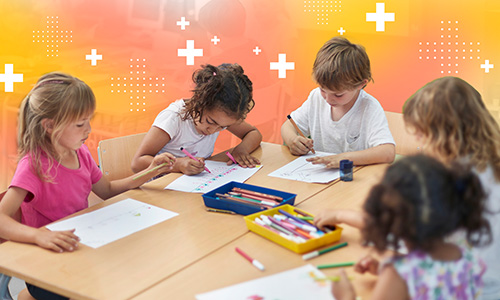
At the start of the 2020–21 school year, the COVID-19 pandemic continued to inflict massive disruptions on all aspects of daily life, presenting educators, students, and their families with enormous challenges, even as many schools began to reopen. Although the severity of these challenges varied across schools, districts, and states, the 2020–21 academic year was far from normal for everyone. A critical question remains: to what extent did these disruptions affect students’ achievement?
This week, NWEA released its latest research examining the impacts of COVID-19 on education outcomes. Our researchers built upon our initial findings to study students’ academic progress one year into the pandemic. As school districts plan for recovery and acceleration of learning post-pandemic, it is critical to identify which students have been most affected and how schools can continue to help students reclaim their learning opportunities.
Academic achievement is only one dimension of students’ education, and these data alone cannot paint a complete picture of how young people fared this past year.
About our study
Using data from 5.5 million students in grades 3–8 who took MAP® Growth™ assessments in reading and math, we examined two primary research questions: 1. How do gains across the 2020–21 school year compare to pre-pandemic trends? 2. How does student achievement in spring of 2021 compare to pre-pandemic levels? As a benchmark, we looked back to 2018–19, the most recent academic year unaffected by COVID-19, and found that:
- On average, third through eighth graders across most grades made reading and math gains in 2020–21.
- Students made gains during the 2020–21 school year at a lower rate compared to pre-pandemic trends, especially between winter and spring.
- Students ended the year with lower achievement compared to a typical year, with larger declines relative to historical trends in math (8 to 12 percentile points) than in reading (3 to 6 percentile points).
- Achievement was lower for all student groups in 2020–21; however American Indian and Alaska Native (AIAN), Black, and Latinx students, as well as students in high-poverty schools, were disproportionately impacted, particularly in the elementary grades we studied.
Students made gains in 2020–21, but at a lower rate
To assess students’ gains in 2020–21, we calculated mean RIT scores for the fall, winter, and spring of the 2020–21 school year and for the same test seasons in 2018–19. Figure 1 plots the means for third-, fifth-, and seventh-grade students for each test period, connected with a straight line to show average gains for each school year (2018–19 has a dotted line and 2020–21 a solid one). Note that we depicted just these three grades to simplify the figure. Similar patterns were observed across all grades we studied.
Comparing mean trajectories for 2020–21 to 2018–19, we see that, in aggregate, students made some gains: the solid lines show a general upward trajectory across the majority of grades and subject areas. But trajectories were diminished relative to a typical year: the solid and dotted lines are not parallel.
Figure 1. Mean MAP Growth RIT scores for selected grades in reading (top panel) and math (bottom panel)
 Students’ achievement at the end of the 2020–21 school year was lower compared to pre-pandemic levels, with larger declines in math
Students’ achievement at the end of the 2020–21 school year was lower compared to pre-pandemic levels, with larger declines in math
In addition to asking how students’ gains over the 2020–21 school year compared to 2018–19, it is important to understand where students ended the school year to plan for what to expect when students return to the classroom in the fall of 2021. Accordingly, we examined spring 2021 achievement levels (based on NWEA 2020 MAP Growth norms) compared to spring 2019.
To summarize end-of-year achievement this year relative to a typical year, we calculated the median achievement percentiles for students in spring 2021 and spring 2019 as well as the difference in percentile rank between these years. Figure 2 displays the achievement levels of the pre-pandemic and pandemic cohorts, as well as the difference between the two, separately by grade level for reading (left panel) and math (right panel).
We previously reported that students began fall 2020 with reading achievement roughly comparable to historical averages. However, we now see declines of between 3 to 6 percentile points in reading achievement in the spring of 2021 relative to pre-pandemic spring achievement levels. In math, students entered the 2020–21 school year achieving 5 to 10 percentile points lower than same-grade students in a pre-pandemic year. We find that the differences in math achievement relative to pre-pandemic trends have increased over the 2020–21 school year and students’ average spring 2021 math achievement is now between 8 to 12 percentile points lower than a typical year.
Figure 2. MAP Growth percentile rank difference comparing same-grade students in spring 2019 (circle) to students in spring 2021 (arrow) in reading (left panel) and math (right panel)

Note: The circles represent the median percentile rank for the pre-pandemic (spring 2019) cohort and the arrows represent the change in median student percentile rank for the spring 2021 cohort.
Spring achievement declines were particularly evident for students in grades 3–5
Achievement was lower in math and reading for all grade levels, but slightly larger differences were observed in the earliest grade levels we examined, corresponding to the late elementary school period. The declines for third-, fourth-, and fifth-graders were larger in magnitude than those for older students by 1 to 3 percentile points in reading and 3 to 4 percentile points in math.
Historically marginalized and economically disadvantaged students were disproportionately impacted, showing larger declines in math and reading relative to advantaged peers
In Figure 3 we show percentile rank changes disaggregated by student race/ethnicity. This allows us, for example, to situate the achievement of Asian American students in spring of 2021 relative to the achievement of a cohort of Asian American same-grade students in the spring of 2019. Here you can see all student groups were impacted in reading and math. However, the magnitude of these differences was uneven across student groups. Asian American and White students showed declines of a smaller magnitude relative to overall averages and relative to other student groups; AIAN, Black, and Latinx students showed declines of a greater magnitude. The disproportionate size of these declines is particularly concerning given the differential spring 2019 achievement status between these student groups. Put simply, the students who could least afford to lose ground relative to other students are those who were the most impacted, and especially so in math.
Figure 3. MAP Growth percentile rank difference by cohort and race/ethnicity in reading (upper panel) and math (lower panel)

Note: The circles represent the median percentile rank for the pre-pandemic (spring 2019) cohort and the arrows represent the decline in median student percentile rank for the spring 2021 cohort.
In Figure 4 we show percentile rank changes by school poverty level. Here we see that students in more economically disadvantaged schools were the most impacted by the pandemic. In many grades, students attending high-poverty schools showed more than double the declines of students attending low-poverty schools. This uneven pattern of declines occurred amidst already unequal starting status differences between students in high- versus low-poverty schools. Students in low-poverty schools in 2020–21 still achieved well above the national average, even with percentile point declines ranging from 6 to 9 percentile points. In contrast, the pre-pandemic cohort of students in high-poverty schools achieved well below national averages and the declines we see in the 2020–21 cohort have served to widen already significant achievement disparities between these two groups.
Figure 4. MAP Growth percentile rank change by cohort and poverty level in reading (upper panel) and math (lower panel)

Note: The circles represent the median percentile rank for the pre-pandemic (spring 2019) cohort and the arrows represent the decline in median student percentile rank for the spring 2021 cohort.
Call to action
These findings tell an alarming story of how students fared academically during the 2020–21 school year compared to what we first reported in the fall. As we summarized in a recent report for the National Urban League, the pandemic has exacerbated longstanding educational inequalities for marginalized students; over the last year, students of color were less likely to be learning in person and more likely to run into obstacles in accessing instruction compared to white students. The unequal impacts of the pandemic extend beyond education; communities of color were more likely to bear the economic and health consequences of the pandemic. The compounding toll of these burdens appears to be borne out in our findings. We find the largest achievement declines for AIAN, Black, and Latinx students, and for students attending high-poverty schools. These declines are of greater magnitude in math than reading and for younger students. Altogether, these results highlight the devastating impact of the COVID-19 pandemic on specific groups of students, as well as how the pandemic exacerbated pre-existing inequities in educational opportunities and outcomes.
We cannot return to the classroom and do things the same as they have always been done and expect to see a different outcome.
Academic achievement is only one dimension of students’ education, and these data alone cannot paint a complete picture of how young people fared this past year. For instance, our results cannot speak to the many ways students, families, and teachers have showed incredible resiliency and adaptability in the face of immense challenges that completely upended normal life. We look forward to learning from these bright spots in the coming months.
In the meantime, our latest findings underscore that there is much work to be done on the path to recovery. As daily life increasingly returns to “normal,” we must confront what this means in the context of education. As our findings show, even if recovery is swift and students return to pre-pandemic levels of achievement, significant inequities will persist. Thus, our collective call to action is clear: next year cannot be a “normal” year. We cannot return to the classroom and do things the same as they have always been done and expect to see a different outcome. Instead, we must use this critical moment in education to radically rethink how programs, policies, and opportunities are allocated, and we must be fiercely committed to prioritizing the communities most impacted by the pandemic.
We look forward to being a partner in the hard work ahead. To learn more about the research and hear from fellow educators about what’s been working well and how best to support students in the fall and beyond, watch our webinar “Research meets practice: How educators are responding to the latest COVID-19 impact results.”
Karyn Lewis, senior researcher with the NWEA Center for School and Student Progress, contributed to this research and blog post.








